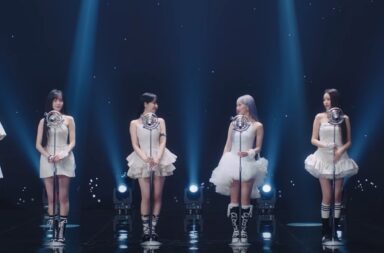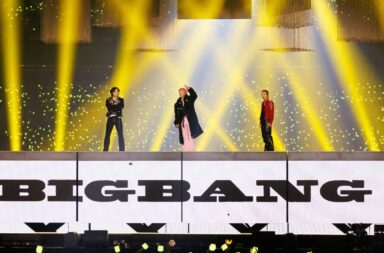DSP Media has a few groups under its label: Rainbow, A-Jax, and dubiously SS501 are some. But the current jewel in their crown, the DSP flagship group, is none other than Kara. Having spent much time and money (well, a fair amount of money) in making them the popular, Korea- and Japan-straddling sensations that they are now, it is understandable that DSP would not want that effort to go to waste. And so, when members Nicole and Jiyoung decided split ways with the company, DSP simply went to plan B.
Plan B was, as we know now, to recruit a new member: after all, Kara had been through a member change before, so why not another? Kara Project saw seven DSP trainees compete for the position, which was ultimately awarded to “pure and sexy” Youngji. There were rumours of the remaining three members of Kara — Gyuri, Seungyeon, and Hara — not approving of a member addition, but any qualms they might have had are nowhere to be seen in their first MV together, “Mamma Mia.”
If you’re looking for a plot, I have some bad news for you. There is one, but it makes little sense; the main focus is on the girls just being girls and doing girl things, like looking pretty, in their palatial abode. Gentle femininity is the concept in this MV, emphasised by the soft focus effect on the solo cuts; the girls wear lacy clothes in pastel tones, surrounded by flowers and bathed in warm light. Butterflies appear, bringing out the girls’ curiosity, followed by joy. Aww, look at how they smile so prettily as the butterfly flutters away.
 After they escape Kara’s gaze, they fly on outside. However, as the sun sets, a butterfly explodes, signalling the start of Kara’s outdoor party. Why does the butterfly explode? Perhaps it’s a symbol of Kara bursting with happiness? A visualisation of the feisty spark within even the most demure woman? Or maybe, as mentioned earlier, this plot makes little sense? You be the judge. At least the party scenes make sense in the context of the lyrics, where the chorus goes: “Everyone’s party party party/ Mamma mia.”
After they escape Kara’s gaze, they fly on outside. However, as the sun sets, a butterfly explodes, signalling the start of Kara’s outdoor party. Why does the butterfly explode? Perhaps it’s a symbol of Kara bursting with happiness? A visualisation of the feisty spark within even the most demure woman? Or maybe, as mentioned earlier, this plot makes little sense? You be the judge. At least the party scenes make sense in the context of the lyrics, where the chorus goes: “Everyone’s party party party/ Mamma mia.”
The dancing scenes, meanwhile, showcase a more mature femininity. Alternating between black and white outfits with their dancers, Kara body wave their way through slick choreography, centred mainly on the upper body. There aren’t any controversial moves like in “Step,” (unless you count the implied cunnilingus in the second verse) but the hand- and arm-related moves require a level of synchronisation that is adequately met by the members. The execution may lack a breath-taking sharpness, but it gets the job done.
As for the music: Duble Sidekick presents us with another pleasant tune: not amazing, but a decent track nonetheless. Horns feature prominently but are muted just enough to allow the members’ voices to take centre stage, with the synths also treated the same way. Considering that Kara is not a group known for its vocal dexterity, this is for the best. That said, the vocals do sound a tad over-processed; the members’ individual timbres are still there, but they are harder to make out upon initial listen.
 Listening to the song, however, as soft as it may be, it’s a bit difficult to reconcile its brassy sound with the super feminine settings in which Kara is shown. There is a disconnect, with the song and dance cuts on one side, and everything else on the other. Either DSP was being overly ambitious or cutting corners and not bothering to really check how the visual component of Kara’s new concept would go with the performance side.
Listening to the song, however, as soft as it may be, it’s a bit difficult to reconcile its brassy sound with the super feminine settings in which Kara is shown. There is a disconnect, with the song and dance cuts on one side, and everything else on the other. Either DSP was being overly ambitious or cutting corners and not bothering to really check how the visual component of Kara’s new concept would go with the performance side.
At the end of it all, though, the aim was to make Kara look good, and that was definitely achieved in this MV. Whatever the clash in styles, the members looked gorgeous in almost every single frame. And the MV is still decidedly feminine as well, so there’s that.
Overall rating: 3.25 out of 5
Readers, what did you think of Kara’s “Mamma Mia” MV? Would you agree that there was a concept clash, or did you like the overall result? Let us know in the comments!


